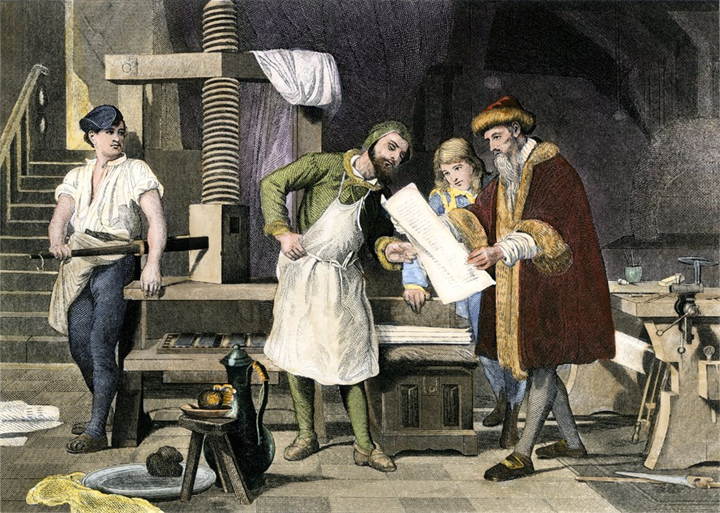Gutenberg, Zeitgeist, and the Myth of the Creative Revolution
We all know the story. In the 1450s, a German goldsmith named Johannes Gutenberg invented the printing press — and suddenly books were everywhere, literacy soared, and the Enlightenment marched us straight to science, moon landings, and microwave ovens. One great pivot point, a before-and-after moment. Right?
Not really.
Every so-called “revolutionary leap” in human history turns out, on inspection, to be less of a lightning strike and more of a slow-burning fuse. Multiple threads, converging at a time and place, taking steps that seem obvious in hindsight. And if we’re honest, history rarely produces pure “culminations.” What we call a culmination is often just another step — sometimes forward, sometimes backward — in the messy churn of human progress.
So, back to Gutenberg.
The Conditions That Made Gutenberg Possible
Imagine a young goldsmith in Mainz around 1450 — trained in metalwork, carrying the skills of a craftsman, the restless heart of an entrepreneur, and more than a little debt. He stands on the banks of the Rhine, a city alive with merchants, barrels of wine, and shipments of paper coming upriver. Ideas are already moving faster than parchment can carry them. Students need textbooks, priests need Bibles, merchants want contracts. Scribes hunched over candlelight simply can’t keep up.
Now step back further. The concept of printing isn’t some brand-new spark. In China, entire Buddhist sutras had been woodblock-printed centuries before. Korea had experimented with movable metal type long before Europe. Even closer to home, Germans were already printing playing cards and calendars with carved blocks. The idea of pressing ink to surface was there — but not yet in a form that could scale.
Then the materials arrive. Paper, cheaper than parchment, floods in from trade routes. Oil-based inks, first designed for painters, turn out to be perfect for sticking to metal. And in the workshops of the Rhineland, screw presses squeeze grapes into wine and olives into oil — the exact mechanical rhythm Gutenberg needed. He didn’t have to imagine a press from nothing. He just had to notice what was already there.
And above it all: the roar of demand. Literacy rising, universities multiplying, the hunger for texts far beyond what any monastery could copy by hand. Economies thrive on contracts, courts on legal codes, churches on Bibles. Gutenberg wasn’t inventing for a hypothetical audience. He was filling a market that was practically begging for a solution.
Seen this way, Gutenberg wasn’t a lone genius conjuring a miracle. He was a craftsman in the right city, at the right moment, with the right threads in his hands. His genius was pulling them tight.
What we see in Gutenberg’s case is a pattern:
Conceptual Groundwork: printing wasn’t an alien idea — it had been circulating in Asia for centuries, and even Europe had woodblock traditions.
Technological & Material Readiness: paper, inks, and mechanical presses had matured into usable tools.
Economic & Political Demand: universities, courts, and churches were crying out for cheaper, faster access to texts.
Together, these conditions created not a sudden leap, but a fertile environment for synthesis. Gutenberg’s true achievement was recognizing the braid and weaving it into a system that could scale.
Other “Not Lightning Strikes”
This pattern repeats.
Atomic Power: The idea of splitting the atom dates back to physicist Ernest Rutherford in 1917, and even earlier in speculative form. The conceptual ground was there. The technological means were slowly emerging through quantum physics and nuclear chemistry. But it wasn’t until the political and military need of World War II that the Manhattan Project fused knowledge, materials, and willpower into Oppenheimer’s bomb at Los Alamos.
Recorded Music to iPod: Thomas Edison’s phonograph dates back to 1877. By the 20th century, we had shellac records, vinyl, magnetic tape. Sony’s Walkman (1979) made music portable. The missing piece was scalable digital storage. Once memory chips shrank and interfaces simplified, the moment was ripe. Jobs and Apple didn’t invent music on the go — they synthesized concept, tech, and market demand into the iPod (2001).
The Rule of Three
Innovation happens when:
Conceptual understanding
Technologcial and practical means.
Political and economic will and need.
No alignment, no revolution.
Genius isn’t just invention. It’s convergence.
- References
Elizabeth Eisenstein, The Printing Press as an Agent of Change (1979)
Lucien Febvre & Henri-Jean Martin, The Coming of the Book (1958/1976)
Adrian Johns, The Nature of the Book (1998)
Lisa Jardine, Worldly Goods: A New History of the Renaissance (1996)
Thomas Pettitt, “Bridging the Gutenberg Gap” (2007)

